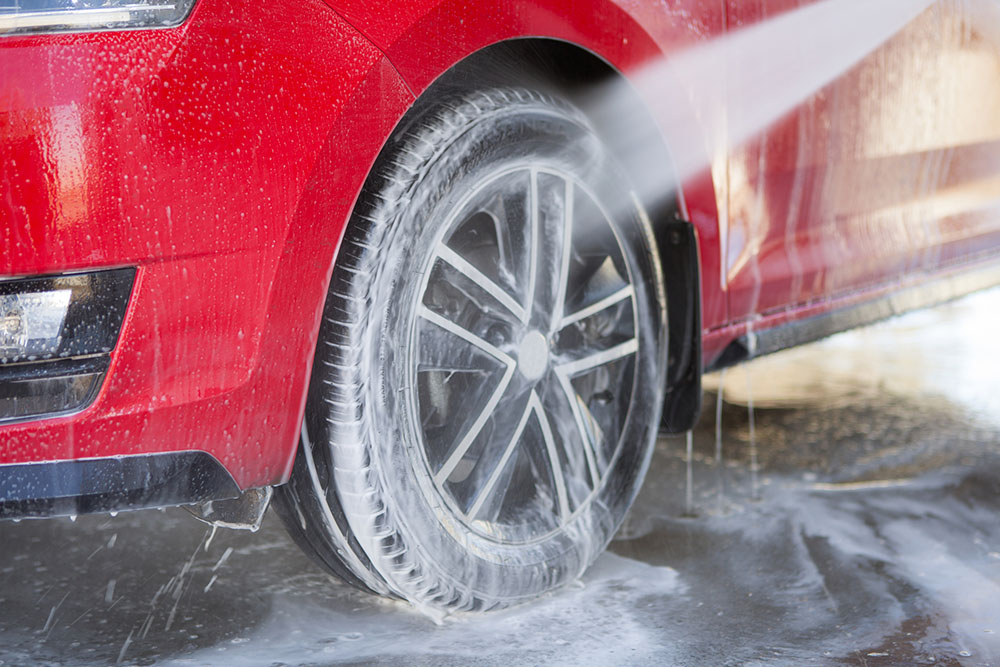How A Car Car Pro Fights Back Against Autumn Road Grime

A few preventative steps can protect your vehicle no matter what weather you encounter on your travels this November--and provide a healthy cabin for you and your passengers.
According to Mike Pennington of Meguiars, early autumn rains create a grimy mess on your shiny vehicle.
Oils and grease accumulated on roadways during summer leach out during early autumn rains. Contaminants cling to all vehicle surfaces and are carried inside your vehicle through soiled shoes and dripping clothes.
What to do?
Pennington uses a power washer on his vehicles to spray the undercarriage and wheel wells–places where road grime can accumulate and cause corrosion. He suggested using a power washer to remove heavy build-up underneath the vehicle and behind wheel wells.
Pennington suggests using a coin operated or drive-through car wash for heavily soiled vehicles. Yet, an automated car wash may not remove built-up residue in hard-to-reach places.
Pennington runs his hand along the vehicle surface. He’s looking for a gritty texture of bonded contaminants.
Synthetic Clay bars are made specifically for use on automobiles. The synthetic, putty-like material gently pulls contaminants off painted surfaces like a magnet picking up pieces of metal.
Afterward, Pennington likes to remove any remaining film or residue by hand-washing the vehicle. For insect parts stuck to paint and trim, use bug goo remover to take off insect parts. Otherwise, the acid in insect goo can cause permanent stains.
“Any contaminants left on the surface of the vehicle prevent wax from adhering properly and reduce its effectiveness,” Pennington said. “After your vehicle is clean, then apply wax protection.”
Does water bead up and roll off the surface? It should, Pennington said.
Failing that test, Pennington completes another round of cleaning and coat of wax. Different climates and driving conditions affect how long the wax remains effective, Pennington said.
Pennington’s personal recommendations for November car care:
-
Vacuum carpets thoroughly. Moisture accumulating on and under carpeting can cause mold and odors. Mold is difficult to eliminate once it germinates.
-
Prevent paint stains and corrosion. Remover early autumn grime before washing and washing. Use an automated car wash or home power washer. Clean off the undercarriage, wheel wells, wheel “windows” and inside the barrels of the wheel.
-
Feel the vehicle surface for sandpaper-like patches. The rough spots are caused by contaminants–pollen, dust, bird droppings, bug goo–bonded to painted surfaces. Use a synthetic clay bar made for automobile surfaces to extract the contaminants.
-
Vacuum the interior thoroughly. Remove dirt, pollen and spores nestled in fabric fibers throughout the interior. Moisture can turn contaminated carpet into petri dishes for mold and related odors.
-
Wipe down all seating and upholstery surfaces. Clean soiled surfaces of coffee spills and sugary drinks–they attract grime throughout winter months and also can lead to discoloration.
-
Use the correct window cleaner. Purchases a solution designed for automobile glass to eliminate streaks and prevent damage to tinted glass film. Remove filmy build-up caused by off-gassing from upholstery, plastics and smoke inside the cabin.
-
Apply quality wax. Carnauba and synthetic waxes remain popular and effective at preventing grime from adhering to vehicle surfaces. The latest ceramic-based waxes provide a sturdier shield that extends protection compared to traditional wax products. Look for “SIO2 technology” or “ceramic-infused.”
-
Add a coat of wax to the wheels, too. Road grime leftover from summer can cause pitting and stains. A layer of wax protection helps keep them protected and looking sharp through winter.
-
Check your headlights for oxidation. Hazy, yellowed lenses are caused by ultraviolet rays of summer sun. Use a lens restoration kit to brighten your nighttime view. The goal is clarity, Pennington emphasized.
-
Treat leather seats with a conditioner to keep them supple. This step is especially important for drivers in warm locations such as California and Arizona where the hot summer sun bakes interior surfaces.
-
Don’t let rainwater dry on vehicle surfaces. They can cause water spotting and attract contaminants. After a rain shower, wipe off water beads with a silicon blade made for automobiles, or you also can remove droplets with your yard blower.
-
Install rubber floor mats. Mold from moisture in your carpeted areas can lead to allergy and odor problems. Mats help prevent water from skiing, hiking and trail-running from coming into contact with carpeted surfaces.
-
Add a cargo liner. Cargo areas are notorious breeding grounds for mold.
-
Consider a roof rack. Stow wet gear and clothing out of the cabin entirely in a secure, aerodynamic roof container.
-
Use seat covers for cloth seats. They can help prevent moisture and grime from embedding into the fibers during winter months.
“Frequent car care is easy car care,” said Pennington, who takes pride in driving a sparkling vehicle throughout winter.